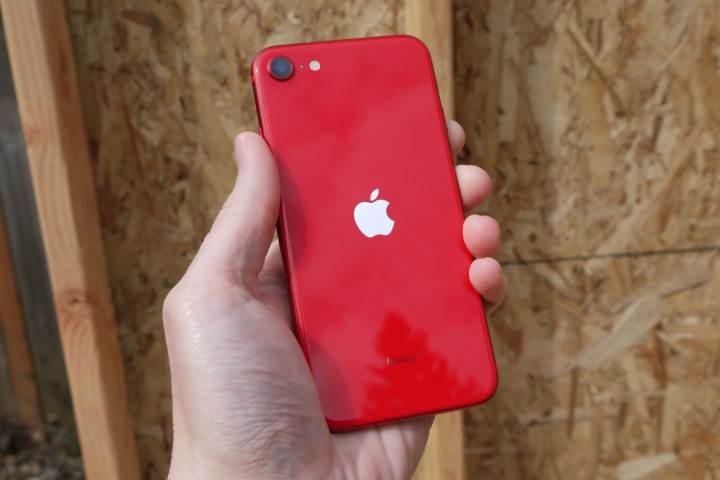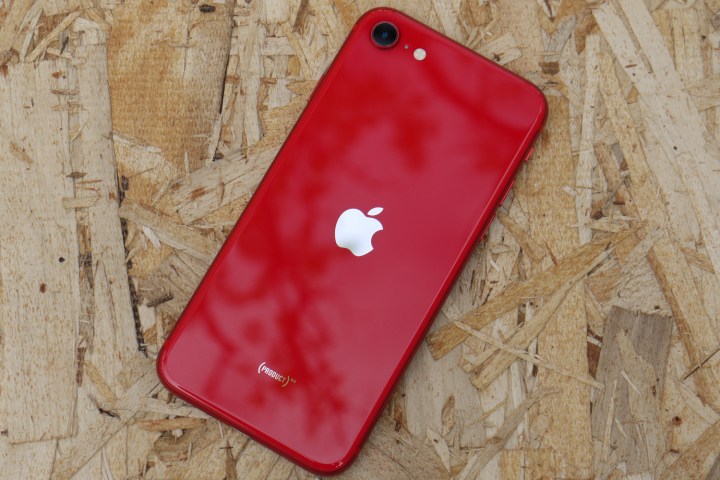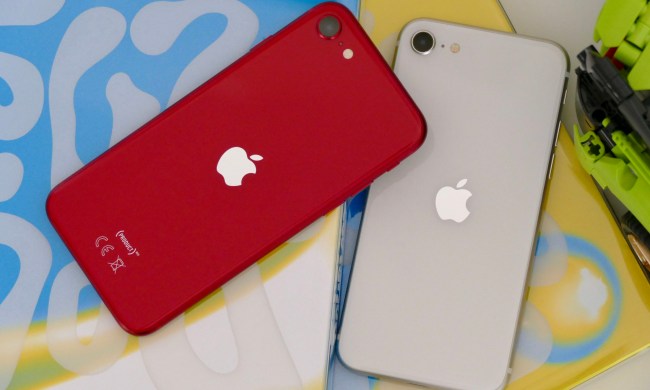Apple and Samsung have announced their ‘budget’ smartphones for 2020. Apple’s iPhone SE is the second generation of its 2016 mobile of the same name, except this time it features the powerful A13 Bionic chip and the physical dimensions of the iPhone 8. Meanwhile, Samsung’s Galaxy A51 is the successor to last year’s Galaxy A50, which provided beautiful looks and a versatile camera for a more affordable price than Samsung’s flagship models.
Both the new iPhone SE (2020) and the Samsung Galaxy A51 are priced at $400, making them direct competitors with each other. However, which one is better? To answer this question, we compare the devices across a range of key categories, including specs, display, performance, camera, battery life, software, and special features.
Specs
| iPhone SE | Samsung Galaxy A51 | |
| Size | 138.4 x 67.3 x 7.3 mm (5.45 x 2.65 x 0.29 inches) | 158.5 x 73.6 x 7.9 mm (6.24 x 2.90 x 0.31 inches) |
| Weight | 148 grams (5.22 ounces) | 172 g (6.07 ounces) |
| Screen size | 4.7-inch Retina IPS LCD | 6.5-inch Super AMOLED |
| Screen resolution | 1,334 x 750 pixels, 16:9 ratio (326 pixels per inch) | 2,400 x 1,080 pixels, 20:9 ratio (405 ppi) |
| Operating system | iOS 13 | Android 10 |
| Storage | 64GB, 128GB, 256GB | 64GB, 128GB |
| MicroSD card slot | No | Yes |
| Tap-to-pay services | Apple Pay | Google Pay |
| Processor | Apple A13 Bionic | Exynos 9611 |
| RAM | 3GB | 4GB, 6GB, 8GB |
| Camera | 12-megapixel rear, 7MP front | 48-megapixel wide, 16MP ultrawide, 5MP macro, 5MP depth rear, 32MP front |
| Video | 4K at 60fps, 1080p at 240fps | 4K at 30fps, 1080p at 120fps |
| Bluetooth version | 5.0 | 5.0 |
| Ports | USB 2.0 | USB 2.0 |
| Fingerprint sensor | Yes, front-mounted (on Home button) | Yes, in-display |
| Water resistance | IP67 | IP68 |
| Battery | 1,821mAh
Fast charging (18W) Qi wireless charging |
4,000mAh
Fast charging (15W) |
| App marketplace | Apple App Store | Google Play Store |
| Network support | AT&T, T-Mobile, Verizon | AT&T, T-Mobile, Verizon |
| Colors | Black, white, red | Prism Crush Black, white, blue, pink |
| Prices | $400, $520 | $400, $500 |
| Buy from | Apple, AT&T, Best Buy, Sprint, T-Mobile, Verizon, Walmart, Xfinity | Samsung, Amazon, Best Buy, T-Mobile, Verizon, Walmart |
| Review score | 4 out of 5 stars | News |
Design, display, and durability

The iPhone SE (2020) and the Galaxy A51 take opposing approaches to their aesthetics. Basically, the new iPhone SE is an iPhone 8 with more modern hardware. As such, it has the same dimensions as the older phone and shares the same thick bezels, as well as the physical Home button. Some people may be charmed by what could now be described as a ‘retro’ look, but others will find it outdated.
By contrast, the appearance of the Galaxy A51 is based around Samsung’s flagship range, the Galaxy S20. It features a display that’s interrupted only by a punch-hole selfie camera, giving it a very contemporary and stylish appearance. The larger display boasts a larger 2,400 x 1,080-pixel resolution, but even with the bigger size of its screen (6.5 inches compared to 4.7), this works out at more pixels per inch, giving the A51 a sharper, more vibrant display than the SE.
One point in the iPhone SE’s favor is that it’s smaller and feels better to hold. The A51’s larger dimensions make it harder to grip, while the relatively cheap plastic casing on its rear may end up being slippery for some (particularly if the A50 is anything to go by).
As for durability, the iPhone SE comes with an IP67 rating, enabling it to survive brief drops into water. This is good, but the Samsung Galaxy A51 goes one better, having an IP68 rating, which indicates that it can withstand longer immersions in water.
Winner: Samsung Galaxy A51
Performance, battery life, and charging

Yes, the iPhone SE is a design throwback. However, Apple has packed it with its powerful A13 Bionic processor, the same as the iPhone 11 range. So even though we haven’t yet had enough time to fully road-test the new SE, you can be almost certain that it will run apps and perform tasks at a high level.
The Samsung Galaxy A51 also packs plenty of computing power into its lower-cost case, although in a different way. It comes with Samsung’s own Exynos 9611 processor under the bonnet. The 9611 isn’t quite as fast as the Qualcomm Snapdragon 865, which is used on Samsung’s current premium models. That said, the A51 comes with 4GB of RAM, which is more generous than the iPhone SE’s 3GB. However, Android and iOS use RAM differently, so even with the extra 1GB, the A51 might struggle to keep up with the SE.
The Galaxy A51 performs better in terms of battery life. While the iPhone SE’s battery has a capacity of 1,821mAh, the A51 offers 4,000mAh. As with the A50, this means it’s likely to last a day even under heavy use, while the SE might struggle to make it through a full day if you’re an avid gamer or film buff.
On the other hand, the new iPhone SE offers 18W fast charging, as opposed to the A51’s 15W fast charging. It also allows wireless charging, which compensates for the shorter battery life.
Winner: iPhone SE
Cameras

The Galaxy A50 had a surprisingly strong triple-camera system for a cheaper smartphone. The A51 goes one further, adding a 5-megapixel macro camera to an improved 48-megapixel wide lens, a 12-megapixel ultrawide lens, and a 5-megapixel depth sensor. Basically, the macro camera helps you take more detailed and vivid close-up photographs, while the more powerful wide and ultra-wide lenses will improve the clarity and vividness of your normal pictures.
The iPhone SE sports only a single 12-megapixel rear camera. This might not sound like much on paper, but the SE comes with optical image stabilization, portrait mode, panorama mode, and the A13 Bionic’s Neural Engine, which all help to squeeze all 12-megapixels for everything they’re worth. However, it still doesn’t quite compare with the A51’s four-lensed system, particularly if you aim to take higher quality or more creative photographs.
Still, the iPhone SE does let you record 4K video at 60 frames per second, while the best the A51 can muster is 4K at 30 fps. Nonetheless, given that most people are usually more interested in taking photos than shooting film, we’re going to give this round to the Galaxy A51.
Winner: Samsung Galaxy A51
Software and updates

The usual Android vs. iOS competition is complicated here a little by the Galaxy A51’s tweaked operating system. It runs Samsung’s One UI 2 interface, which is built on Android 10. As we found with the A50, it’s one of the best Android skins on the market, offering a smooth user experience. Having said that, One UI 2 doesn’t introduce any significant changes as far as we’ve seen.
The new iPhone SE (2020) runs on iOS 13, which for the first time brings a dark mode, as well as performance and privacy improvements. This doesn’t necessarily make it better than One UI 2, but it does show that the SE’s software offers more new things compared to its predecessor.
One thing that is better with the iPhone SE compared to the Galaxy 51 is the updates. Apple delivers updates to its operating systems at a rapid click, while Samsung has often been slow to deliver Android updates, infamously taking almost half a year to bring Android 9.0 Pie to the Galaxy S9 series. For this reason, we have to say that the iPhone SE is just about better when it comes to software.
Winner: iPhone SE
Special features

Neither the iPhone SE nor the Samsung Galaxy A51 offer any significant special features. Basically, they’re both affordable versions of more premium models, which means that they mostly strip out some of the more unique features of their pricier stablemates.
For example, the iPhone SE gets rid of the iPhone 11’s TrueDepth selfie camera and Face ID. Meanwhile, the Galaxy A51 lacks the 120Hz refresh rate of the Galaxy S20 and also the latter’s impressive 563 pixel-per-inch screen.
However, one trick the Galaxy A51 does have up its sleeve is that it also comes as a 5G version (not yet released). To be fair, 5G networks aren’t particularly extensive at the moment, but the option to add 5G (for an additional $100) future proofs the phone in a way unavailable to the iPhone SE.
Winner: Samsung Galaxy A51
Price and availability
The iPhone SE (2020) is currently available and costs $400 for the 128GB version, while the 256GB model will set you back $550. It’s available from a range of major outlets, including AT&T, Best Buy, Sprint, T-Mobile, Verizon, Walmart, and Xfinity Mobile.
Likewise, the Samsung Galaxy A51 starts from $400, but if you want the 5G version, you’ll have to pay $500, although it hasn’t been released yet. The standard version is being sold through Amazon, AT&T, Best Buy, Sprint, Verizon, and Walmart.
Overall winner: iPhone SE
Despite their different strengths and weaknesses, the iPhone SE and Samsung Galaxy A51 are evenly matched. The Galaxy A51 looks better, has a better screen, and a more powerful camera. On the other hand, the iPhone SE has a perfectly serviceable display and camera, but also offers superior computing performance and slightly better software (at least in terms of updates). It’s a close match, but for us, the iPhone SE’s stronger processor and speedy and long update schedule make it the slightly better of the two for the budget-conscious.
However, it’s not a clear win. If you’re an Android fan, it’s clear which you should pick. Also, if you compare the Galaxy A51 5G version with the iPhone SE, then you’d have a stronger case for concluding that the A51 is slightly better than Apple’s budget phone. We haven’t had the opportunity to look at the 5G version, which isn’t even available yet, but the superior speeds of 5G would make the A51 a noticeably better machine for surfing the web while on the move.



